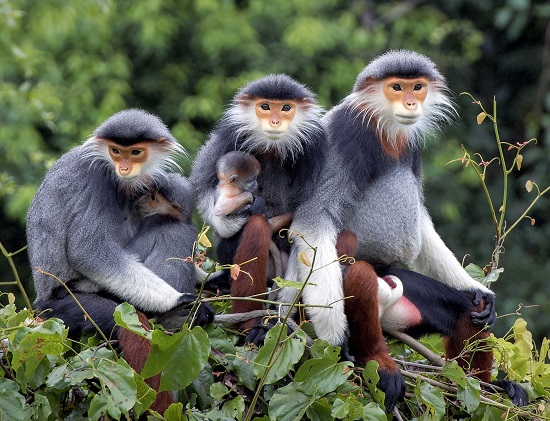More effort needed to protect red-shanked douc langurs
The Son Tra Peninsula is now home to a total of around 1,335 red-shanked douc langurs, divided into 237 troops, and their natural habitat covers a total area of 30km2 on the peninsula.
 |
| Red-shanked douc langurs |
Thanks to the unique beauty of its 5 impressive colours, the red-shanked douc langur has been recognised by the Wildlife at Risk international organisation as the ‘queen’ of the primate species. It also belongs to Group IIB which is rare animals restricted from being held in captivity, hunted, traded or killed. Most notably, this species of primate is listed in Viet Nam’s Red Book, and is on the International Union for the Conservation of Nature (IUCN) Red List of Threatened Species.
These facts were released at a workshop on Monday held to announce some scientific work on the red-shanked douc langurs living on the peninsula, and to discuss more effective measures to protect them.
The event was jointly organised by the municipal Union of Science and Technology Associations and the city-based GreenViet Biodiversity Conservation Centre.
It was also announced at the workshop that the peninsula boasts a very diversified ecosystem as there are 985 species of vascular plants and about 300 species of vertebrate animals. Also, the sea off the peninsula boasts 191 types of coral, along with 72 and 3 seaweed and seagrass species respectively.
Many experts at the seminar remarked that the natural habitat of the red-shanked douc langurs on the peninsula is gradually shrinking due to the growing number of tourism and transport infrastructure development projects there. Also, the peninsula has seen a significant decrease in the number of these animals in recent years due to illegal hunting, forest destruction activities, and other related issues.
Mr Bui Van Tuan, the Manager of the Scientific Research Department of the GreenViet Centre, suggested that the city authorities should conduct more inspections of tourism activities on the peninsula, and halt the construction of projects located in the important distribution areas of the douc langurs, on the northern side of the peninsula.
Furthermore, greater efforts should be made to combat illegal hunting, trapping and forest destruction activities. In particular, signboards should be placed alongside some internal roads where the red-shanked douc langurs usually cross.
Mr Tuan also proposed that greater importance should be attached to increasing the monitoring of the fluctuation and distribution of this animal’s population, and evaluating the problem of genetic depletion due to the impact of their inbreeding.
Special heed should be paid to carefully managing the confinement and release of monkeys back into the wild after they are found being illegally kept by hunters in order to help them avoid infectious diseases which can be transmitted from humans to the animals.